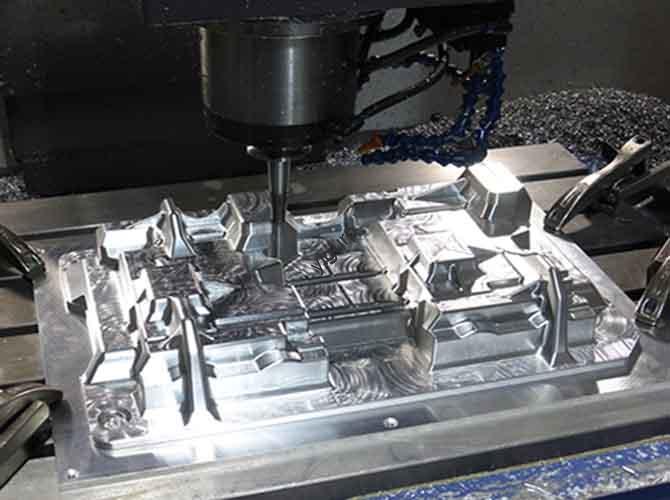Escolhendo o material certo para plastic prototype molds directly impacts the mold’s durability, velocidade de produção, precisão, e custo. There is no “one-size-fits-all” option—materials vary based on project needs like production quantity, complexidade da parte, precision requirements, e orçamento. This article breaks down the most common materials, seus prós e contras, casos de uso, and a step-by-step guide to select the best fit.
1. Common Materials for Plastic Prototype Molds (Tabela de comparação)
Below is a comprehensive overview of 6 widely used materials, including their key traits and application scenarios:
| Categoria de material | Specific Types | Principais vantagens | Principais desvantagens | Ideal Application Scenarios |
| Liga de alumínio | 6061, 7075 | – Leve (easy to handle) – Excelente máquina (produção rápida) – Boa condutividade térmica (faster cooling for parts) | – Low hardness (wears quickly) – Not suitable for high-volume production | Small/medium-sized prototypes, trial samples, appearance parts (Por exemplo, protótipos da caixa de telefone) |
| Aço | P20, H13, 45# Aço | – Alta dureza (resistente ao desgaste) – Suitable for medium/large molds – Resistente ao calor (works with thermoplastics) | – Pesado (hard to transport/operate) – Long processing cycle – Alto custo | Partes funcionais, complex-structure prototypes, high-volume production molds (Por exemplo, automotive component molds) |
| Bakelite (Fenólico) | Phenolic resin-based | – Baixo custo (budget-friendly) – Fácil de processar (fast mold making) | – Baixa resistência (prone to breakage) – Baixa resistência ao desgaste – Baixa precisão | Low-precision, Pequeno-lotes, protótipos não funcionais (Por exemplo, simple shape test parts) |
| Epoxy/Polyurethane Resin | Resina epóxi, poliuretano | – Prototipagem rápida (cura rápida) – Suitable for soft molds – Low cost for small batches | – Baixa resistência (not durable) – Not for high-precision or long-term use | Simple-shape prototypes, exterior parts, temporary molds (Por exemplo, short-term trial production molds) |
| Copper/Beryllium Copper Alloy | Cobre puro, Beryllium cobre | – Excelente condutividade térmica (fast part cooling) – Good precision retention | – Alto custo (expensive material) – Difficult to process (needs specialized tools) | Peças de paredes finas, componentes de precisão, molds requiring fast cooling (Por exemplo, high-precision electronic part molds) |
| 3D Materiais de impressão | Photosensitive resin, nylon | – No traditional machining needed (direct 3D printing) – Ideal for complex shapes – Fast prototyping for small batches | – Limited strength (não resistente ao desgaste) – Not suitable for high-volume production | Complex-shape prototypes, small-batch rapid molds (Por exemplo, intricate medical device prototype molds) |
2. Key Factors to Consider When Selecting Materials
To avoid 选错 materials (and wasting time/money), follow this 4-step, cause-effect driven guide—each factor directly influences your material choice:
Etapa 1: Define Production Quantity
- Pequenos lotes (1–50 peças): Escolher liga de alumínio, resina epóxi, ou 3D Materiais de impressão (produção rápida, baixo custo).
- Grandes lotes (500+ peças): Opte por aço (resistente ao desgaste, durable enough for repeated use).
- Lotes médios (50–500 peças): Balance with liga de alumínio (if precision needs are moderate) ou low-cost steel (if durability is critical).
Etapa 2: Assess Precision Requirements
- Alta precisão (±0.01mm or tighter): Usar aço (stable dimension retention) ou copper/beryllium copper alloy (excellent precision for small parts).
- Moderate precision (± 0,1 mm): Liga de alumínio ou 3D printing with photosensitive resin funciona bem.
- Baixa precisão (± 1 mm): Bakelite ou resina epóxi is sufficient (budget-friendly).
Etapa 3: Evaluate Budget Constraints
- Baixo orçamento: Priorize bakelite, resina epóxi, ou entry-level 3D printing materials (nylon/PLA-based).
- Medium budget: Liga de alumínio (balances cost and performance) é a melhor escolha.
- Alto orçamento: Investir em aço (para durabilidade) ou beryllium copper alloy (for high precision and cooling speed).
Etapa 4: Analyze Part Complexity
- Formas complexas (Por exemplo, internal hollows, detalhes finos): 3D Materiais de impressão (no need for traditional machining) ou liga de alumínio (easy to mill complex features).
- Formas simples (Por exemplo, painéis planos, basic frames): Bakelite, resina epóxi, ou low-cost steel (fast processing, no extra complexity).
3. Perspectiva da tecnologia YIGU
Na tecnologia Yigu, we believe plastic prototype mold material selection is a “balance of needs” rather than chasing a single “best material.” For most clients—especially startups and small businesses—liga de alumínio (6061) is the most versatile choice: it’s fast to machine, econômico, and precise enough for 80% of prototype needs. Para projetos de alta precisão (Por exemplo, Protótipos de dispositivos médicos), Recomendamos beryllium copper alloy for its cooling speed and precision retention. For budget-limited, simple tests, 3D printed photosensitive resin molds cut lead time by 50% compared to traditional materials. Nosso conselho: Start by listing your top 2 priorities (Por exemplo, “speed + low cost” or “precision + durability”)—this narrows down materials in minutes.
4. Perguntas frequentes (Perguntas frequentes)
- P: Can I use 3D printing materials for plastic prototype molds that need to produce 100 peças?
UM: Depende do material. Photosensitive resin molds are only suitable for 10–20 parts (low wear resistance), mas nylon-based 3D printing materials can handle 50–80 parts. Para 100 peças, Recomendamos liga de alumínio (more durable and cost-effective).
- P: Is steel always better than aluminum alloy for plastic prototype molds?
UM: Não. Steel is better for high-volume, high-wear scenarios, but aluminum alloy is superior for small batches: it’s 3x faster to machine, 1/3 the weight, e 50% mais barato. Choose steel only if you need 500+ parts or extreme durability.
- P: Why is beryllium copper alloy used for thin-walled plastic parts?
UM: Isso é Excelente condutividade térmica (2x higher than aluminum) ensures thin-walled parts cool quickly and evenly, reducing warping or deformation. This is critical for thin parts (Por exemplo, 0.5mm thick electronic casings) where shape accuracy is key.
